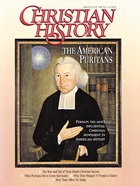Despite the numerous hardships the first Puritan colonists endured on the desolate and flint-edged shores of New England, their chief joy (wrote one of the colonists) “lay not in the increase of Corne, or Wine, or Oyle.” What “rejoyced the Heart of this People much” was the decision of between 80 and 90 Puritan ministers to join these colonists in their self-chosen exile from England, “preaching with all instancy the glad Tidings of the Gospell of Jesus Christ.”
In that age only the tiniest minority of the people could read. An even tinier minority possessed the means to buy books. So public preaching was the clearest and most direct method for Puritanism to appeal to people’s hearts and minds.
Furthermore, preaching was considered an almost-supernatural activity and an indispensable means of receiving divine grace. “The preaching of the Word is the Scepter of Christ’s Kingdome, the glory of a Nation, the Chariot upon which life & salvation comes riding,” Stephen Marshall told Parliament in November 1640. Only the preaching minister, added a note from the Geneva Bible (the Bible of American Puritans), had the authority to “open the gates of heaven with the word of God, which is the right key.”
Whatever else the word Puritan meant in the 1600s in England and the New England colonies, it meant the priority of preaching in the life of a Christian community.
All Manner of Preachers
Of the 300 or so English Protestant ministers who can be readily identified as Puritans in the Church of England in 1630, as many as a third of them (some with their entire congregations) joined the great Puritan migration to Massachusetts and its daughter colonies, Connecticut and New Haven. These preachers came in all varieties.
Thomas Hooker, who emigrated to New England in 1633, had such “a mighty vigor and fervour of spirit” in his preaching that his sermons “would put a king in his pocket.”
Richard Mather of Dorchester had a “loud and big” voice and preached with “a deliberate vehemency.”
John Cotton preached with “a very awful majesty.” His associate, John Wilson, claimed that “Mr. Cotton preaches with such authority, demonstration, and life, that methinks, when he preaches out of any prophet or apostle, I hear him not; I hear that very prophet and apostle; yea, I hear the Lord Jesus Christ himself speaking in my heart.”
Not many of the Puritans had much reputation for humor, although Samuel Moody (pastor of York, Maine, from 1698 to 1747) had a well-known talent for pulpit put-downs. When Moody was invited to preach in a neighboring parish, the pastor warned Moody that the congregation was in the annoying habit of drifting out of church before the sermon was over. Moody solved that problem by announcing at the beginning of his sermon that he intended to speak first to the sinners in the congregation, and then to the saints.
When he had preached to “sinners” as long as he thought proper, he paused and added, “There, sinners, I have done with you now; you may take your hats and go out of the meeting house as soon as you please.” No one dared leave.
No Exotic Words
The Puritan sermon was set off from all other English preaching by a peculiar homiletical technique known as “the plain style”—plain in vocabulary, structure, subject, and style.
Most sermons of the 1600s look, to our eyes, like collections of literary essays or devotional meditations, thick with metaphor and encrusted with elaborate Latin quotations. But because Puritan preaching was intended (according to Robert Cushman) “to paint out the Gospel in plain and flat English, amongst a company of plain Englishmen,” the Puritan preachers opposed elaborate and flowery literary devices.
Richard Mather “was plain, aiming to shoot his Arrows not over his peoples heads, but into their Hearts and Consciences.” For that reason, Mather “studiously avoided obscure phrases, Exotick words, or an unnecessary citation of latine Sentences which some men addict themselves to the use of.”
Although Ezekiel Rogers of Rowley was renowned as a “tree of knowledge,” he was “so laden with fruit that he stooped for the very children to pick off the apples ready to drop into their mouths.”
At the same time, the preaching handbooks most popular in New England all permitted the plain preacher an array of rhetorical devices, the favorite of which was similitude. This was an illustration that compared spiritual truths with everyday experiences to bring home a spiritual point.
Thomas Hooker, pastor at Hartford, Connecticut, used this simile in a sermon: “When the father is going on in his journey, if the child will not goe on, but stands gaping upon vanity, and when the father calls, he comes not, the onely way is this: the father steps aside behind a bush, and then the child runs and cries, and if he gets his father againe, he forsakes all his trifles, and walkes on more faster and more cheerefully with his father than ever.
“So when the Lord Jesus Christ sometimes makes knowne himselfe to us, and would carry us on in a Christian course cheerefully, we are playing with trifles, and grow carelesse, and cold, and worldly, and remisse in prayer, and dead hearted; the onely way to quicken us up is to hide himselfe, and to make us give ourselves for lost; & then they that could scarcely pray once a weeke, now will pray three or foure times a day.”
Memorable Outlines
The plain style is perhaps best known for the simple four-part outline all Puritan preachers used:
Text: The preacher would “open up” a text—to explain one by one all the words, ideas, and concepts within a Bible verse (or verses).
Doctrine: The preacher then stated in a single statement a “theological Axiom, either consisting in the express words of Scripture, or flowing from them by immediate consequence.”
Uses: Next, the doctrine needed to be “established,” or proven to be in harmony with the rest of the Bible, and its general implications explained. The preacher would refute any objections that could be raised and point out the practical “uses” of the doctrine for consolation or correction.
Applications: While the “uses” were generally discussed in the third person, the “applications” dropped directly into the second person and allowed the preacher to ask whether the congregation had taken the “doctrine” to heart.
The plain sermon’s outline and logical development made memorization easy and encouraged note taking by the people for review at home.
Crib Notes
The most important part of plainness in the actual delivery of a sermon was the requirement that a preacher look natural and spontaneous in preaching. Nathaniel Mather, in cautioning his nephew Cotton in 1682, explained what this meant: “By any means get to preach without any use of or help from your notes,” since “in New England, no man that I remember used them except one, and hee because of a special infirmity … ” Mather was probably exaggerating, but only a little.
Many New England Puritans at the beginning of their ministries would write out their sermons in full, but they usually took only the most innocuous sets of notes into the pulpit. Some of the less confident crammed a great deal into these notes; some would use six to twelve small sheets, with up to two hundred words per page, cut to the size of their palms.
Sunday Not Enough
Besides sermons on Sunday morning and afternoon, a weekday lecture was also expected of Puritan ministers. In the lecture, the preacher explored intricate theological problems. John Cotton devoted his Thursday lectures in Boston in 1639 and 1640 to an exposition of Revelation 13, which gave Cotton free rein to talk about eschatology. Forty years later, Samuel Willard of Boston delivered 226 lectures on the first 100 questions of the Westminster Shorter Catechism.
Other occasions for preaching included the election sermon. Beginning in 1634, and every year after 1640, the annual election day in Massachusetts was crowned with a sermon before the General Court by a prominent minister. It was clearly expected that the need for community obedience to God would be the subject of the hour (or, more often, hour and a half).
In addition, Puritan colonial governments often called for days of fasting and prayer when the colony encountered a crisis. On such days, ministers were expected to create services and sermons devoted to the crisis at hand. Just as often, the government would declare a thanksgiving day when the crisis passed, and once more, Puritan preachers would ascend their pulpits to dwell on New England’s failure or success as a “city on a hill.”
Purified Preaching
Historian Harry Stout has charted how Puritan preaching shifted over the course of a century and a half. Puritan preachers of the second generation (1660–1700) were fearful that the spiritual vitality of the first generation was fading. Third-generation preachers were more likely to follow elegant English literary models. And the next generation (1730–1760), that of Jonathan Edwards and the Great Awakening, deliberately reappropriated much of the plainness of the first generation.
The plain style, with its urge to understand Christian truth by dividing, sub-dividing, and analyzing a biblical text, has exerted a significant influence in American preaching. Even among those who have little liking for the rigors of New England Calvinism, preaching plainly for plain people “for the building up of faith in God” still plays a silent but commanding role.
The pattern laid down by William Ames in the “Marrow of Sacred Divinity” remains the guiding star for many: “The sum of the matter is that nothing is to be allowed which does not contribute to the spiritual edification of the people, and nothing omitted by which we may surely reach that end.”
Dr. Allen C. Guelzo is associate professor of history at Eastern College in St. David's, Pennsylvania. He is the author of Edwards on the Will: A Century of American Theological Debate (Wesleyan, 1989<).
Copyright © 1994 by the author or Christianity Today/Christian History magazine.
Click here for reprint information on Christian History.

Support Our Work
Subscribe to CT for less than $4.25/month





























